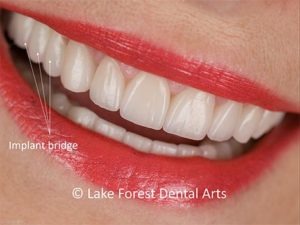
To say something has room for improvement doesn’t necessarily mean that it isn’t an effective solution. For instance, a dental bridge is a highly effective means of replacing a lost tooth. They can be used to replace more than one tooth if there is enough support from the surrounding teeth. When 3 or more teeth are missing, most implant dentists would prefer to place an implant bridge rather than a removable partial denture or a regular bridge. While traditional bridges have stood the test of time as replacement teeth, they still lack the strength and stability of the original natural teeth. To improve its comfort and function, Dr. Fondriest may recommend an implant bridge. This is a bridge supported by dental implants. An implant bridge will provide an excellent long term solution to the loss of several adjacent teeth.
The mechanics of an implant bridge
The basic construct of an implant bridge hasn’t changed drastically over the years. The craftsmanship and materials used to create modern bridges have advanced considerably. An implant bridge consists of an appropriate number of replacement teeth (called pontics) situated between two or more implant crowns. The implants do the work of the original tooth roots. The implants and attached crowns and pontics are placed like regular teeth in the gap in your smile. The abutment implants hold the bridge in place as you bite, chew, speak, and smile.
Supporting a Dental Bridge on Dental Implants
Unlike other modern dental prosthetics, dental implants are surgically inserted root devices designed to replace the roots of your missing teeth. Each implant is carefully placed at an optimal angle to support your bridge while helping preserve your jawbone’s integrity. With the support of dental implants, bridges can more closely mimic the natural teeth they’re meant to replace in comfort, sturdiness, and in the manner with which you care for them.
Caring for Implant Supported Bridges
After your dental implants are surgically placed, your jawbone will fuse to their biocompatible titanium surfaces. It typically takes about 4-6 months to heal. Each implant possesses a connective abutment that protrudes above the gum line, which Dr. Fondriest will use to connect your dental bridge. Since its support reaches below your gums, a dental implant bridge can be cleaned and cared for much like you care for your natural teeth or a regular bridge. To maintain good oral health, be sure to brush your teeth and bridge at least twice every day. It is good to floss at least once/day. This will prevent bacterial plaque buildup that could lead to cavities and gum disease. Also, attend a regular dental checkup and cleaning as often as your dentist recommends to ensure the continued success of your dental bridge, and the health of your oral tissues around it.
Disadvantages of a Conventional Fixed Bridge
In the conventional restoration, teeth on either side of the space are drilled down to retain the abutment teeth. Because implant bridges and regular dental bridges rely on surrounding oral structures for support, your replacement teeth are secured to the adjacent teeth and sealed by your gum tissue, like your natural teeth. The space between your gums and your bridge’s pontics can provide hard-to-reach hiding spots for food debris and bacteria. Left alone, the accumulated germs and debris can lead to gum disease. It can also lead to decay in the teeth that support the bridge. Special flossing techniques and more frequent dental visits may be necessary to keep your mouth healthy and improve the longevity of your dental bridge.
Solutions for All Kinds of Tooth Loss
If you’ve lost a significant amount of teeth, or if the teeth you’ve lost aren’t near to each other, then a tooth supported bridge may not work to replace them. When several teeth have been lost or there are other dental issues, then your dentist should evaluate for a prosthodontic makeover. This is true even if it’s situated on dental implants. Fortunately, implants can also support a dental crown or denture, as well as an implant bridge. Each option addresses every patient’s pattern and severity of tooth loss. If you’ve lost teeth and are looking for the most comprehensive solution to get a tooth replaced, or if you’d like to learn how to improve your existing dental prosthetic, then speak with Dr. Fondriest about your eligibility for dental implants.
Your implants can last for life.
Once your implants have been placed, your jawbone heals to their surfaces, making them permanently a part of your jawbone. This improves the function and stability of your replacement teeth for life, with proper care and maintenance. This makes this type of bridge one of the best replacement options for lost teeth.
Learn more about implant bridges
Aside from providing expert general and restorative dentistry services to our community, Dr. James Fondriest also holds highly-respected academic appointments at the Pankey Institute and the Spear Institute. He is a former Adjunct Associate Professor in the Department of Prosthodontics at the University of Florida Dental School. At Lake Forest Dental Arts, Dr. Fondriest combines his impressive array of experience with modern technology and caring, compassionate, and knowledgeable staff. We proudly serve the Chicago metropolitan area including the North Shore and Northwest suburbs. To schedule your next consultation, call our office today at (847) 234-0517.
Dr. Fondriest is a Nationally recognized and highly sought after cosmetic dentist. He serves clients from throughout the United States
